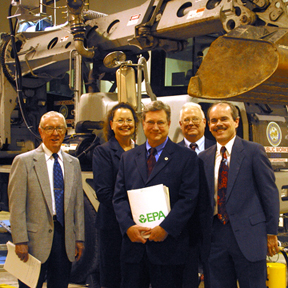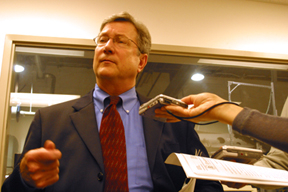At Houston’s newly-developed Diesel Vehicle Research and Testing Facility today, EPA Regional Administrator Richard E. Greene announced the Bush administration’s Clean Air Nonroad Diesel Rule will cut emission levels from construction, agricultural and industrial diesel engines by more than 90 percent. The rule was signed by EPA Administrator Mike Leavitt yesterday.
“These new clean air developments are certain to help Houston achieve cleaner air,” Greene said. “Our scientists expect the health benefits to exceed those resulting from removing lead in gasoline and installing catalytic converters on cars more than 10 years ago. The Clean Air Nonroad Diesel Rule is part of a suite of rules proposed by the administration to give communities across the nation additional tools to meet new, stricter, health-based air quality standards. Local measures including the Diesel Vehicle Research and Testing Facility set Houston apart as a leader.”
Houston Mayor Bill White said, “With these kinds of national tools, local solutions can go further and faster. The federal rules will help us get where we want to go more quickly in improving air quality and providing a healthier environment for our children and families.”
The city of Houston and the University of Houston partnered to develop and construct the Diesel Vehicle Research and Testing Facility to test many of the new air pollution control measures that will soon be in effect for the greater Houston area. The city will use this data to choose the most effective and efficient diesel emission reduction equipment for its fleet of diesel vehicles. Reducing diesel emissions is an important part of meeting new air quality standards.
Michael Harold, professor and chair of the University of Houston (UH) Department of Chemical Engineering, said, “Emerging technologies offer promising possibilities for reducing the pollution in diesel engine exhaust. It is UH’s task to systematically evaluate the effectiveness of these technologies, especially in reducing nitrogen oxides and particulates. We are proud to contribute to Houston’s efforts to improve air quality.”
Wade M. Battles, Managing Director, Port of Houston Authority, said, “Today, we applaud the EPA for taking a bold move for our nation’s air quality by lowering the level of sulfur in diesel fuel. Marine cargo vessels and railroad cars that operate in, out and through the Port of Houston will have a tremendous use for low-sulfur diesel. Moreover, the increased availability of this fuel will greatly reduce costs for the Port of Houston Authority. The port authority is grateful for the EPA’s initiative and we look forward to continuing to do our part for cleaner air and an overall cleaner environment.”
When the full inventory of older nonroad engines has been replaced, the nonroad diesel program will annually prevent as many as 1000 premature deaths in Texas. Nationwide, the rules will prevent as many as 12,000 premature deaths, one million lost work days, 15,000 heart attacks and 6,000 children's asthma-related emergency room visits. The overall benefits of the nonroad diesel program are estimated to outweigh the costs by a ratio of 40 to one.
Last month, EPA announced its determination of the air quality in communities across the nation. In Texas, EPA determined most communities, except the Dallas-Fort Worth, Houston-Galveston, Beaumont-Port Arthur and San Antonio areas, meet the stricter national standard for ozone. Ozone is created by chemical reactions between nitrogen oxides and volatile organic compounds in the presence of sunlight.
More information on EPA’s clean diesel programs, including the Clean Air Nonroad Diesel Rule, is available at: https://www.epa.gov/dera.

